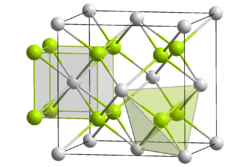Lead(II) fluoride
Lead(II) fluoride is the inorganic compound with the formula PbF2. It is a white solid. It exists as both an orthorhombic and cubic forms.
 | |
| Names | |
|---|---|
| Other names
Lead difluoride plumbous fluoride | |
| Identifiers | |
3D model (JSmol) |
|
| ChemSpider | |
| ECHA InfoCard | 100.029.089 |
PubChem CID |
|
| UNII | |
CompTox Dashboard (EPA) |
|
| |
| |
| Properties | |
| PbF2 | |
| Molar mass | 245.20 g/mol |
| Appearance | white powder |
| Odor | odorless |
| Density | 8.445 g/cm3 (orthorhombic) 7.750 g/cm3 (cubic) |
| Melting point | 824 °C (1,515 °F; 1,097 K) |
| Boiling point | 1,293 °C (2,359 °F; 1,566 K) |
| 0.057 g/100 mL (0 °C) 0.0671 g/100 mL (20 °C)[1] | |
Solubility product (Ksp) |
2.05 x 10−8 (20 °C) |
| Solubility | soluble in nitric acid and hydrochloric acid; insoluble in acetone and ammonia |
| −-58.1·10−6 cm3/mol | |
| Structure | |
| Fluorite (cubic), cF12 | |
| Fm3m, No. 225 | |
| Hazards | |
| Lethal dose or concentration (LD, LC): | |
LD50 (median dose) |
3031 mg/kg (oral, rat) |
| Related compounds | |
Other anions |
Lead(II) chloride Lead(II) bromide Lead(II) iodide |
Except where otherwise noted, data are given for materials in their standard state (at 25 °C [77 °F], 100 kPa). | |
| Infobox references | |
Uses
Lead(II) fluoride is used:[2]
- in low melting glasses
- in glass coatings to reflect infrared rays
- in phosphors for television-tube screens
- as a catalyst for the manufacture of picoline
Preparation
Lead(II) fluoride can be prepared by treating lead(II) hydroxide or lead(II) carbonate with hydrofluoric acid:[2]
- Pb(OH)2 + 2 HF → PbF2 + 2 H2O
Alternatively, it is precipitated by adding hydrofluoric acid to a lead(II) salt solution, or by adding potassium fluoride to a lead(II) nitrate solution.[3]
- 2 KF + Pb(NO3)2 → PbF2 + 2 KNO3
It appears as the rare mineral fluorocronite.[4]
gollark: You forgot strange kek, charm kek, up kek and down kek!
gollark: What if we make it so that proposals are *automatically* passed when the rules state they should be, and directly patch the code of the bot?
gollark: What if we make it so that votes are done by allowing each player to set a few cells of the initial state to a complex cellular automaton, and then the output of that after a few billion steps is parsed into the result of the vote?
gollark: Wait, what if we treat passing/failing proposals as a 1D cellular automaton?
gollark: Oh, and also, pass proposal but translated to Latin, pass proposal 3 days ago, pass proposal *in* 6 days, and randomly reassign all rule numbers.
References
- NIST-data review 1980
- Carr, Dodd S. "Lead Compounds". Ullmann's Encyclopedia of Industrial Chemistry. Weinheim: Wiley-VCH. doi:10.1002/14356007.a15_249.
- Arnold Hollemann, Egon Wiberg, 101st ed., de Gruyter 1995 Berlin; ISBN 3-11-012641-9
- https://www.mindat.org/min-40179.html
This article is issued from Wikipedia. The text is licensed under Creative Commons - Attribution - Sharealike. Additional terms may apply for the media files.